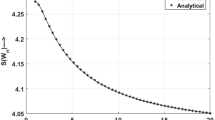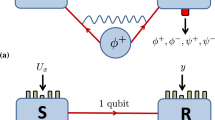Abstract
We analyze the efficiency of multiqubit W-type states as resources for quantum information. For this, we identify and generalize four-qubit W-type states. Our results show that these states can be used as resources for deterministic quantum information processing. The utility of results, however, is limited by the availability of experimental setups to perform and distinguish multiqubit measurements. We therefore emphasize protocols where two users want to establish an optimal bipartite entanglement using the partially entangled W-type states. We find that for such practical purposes, four-qubit W-type states can be a better resource in comparison to three-qubit W-type states. For a dense coding protocol, our states can be used deterministically to send two bits of classical message by locally manipulating a single qubit. In addition, we also propose a realistic experimental method to prepare the four-qubit W-type states using standard unitary operations and weak measurements.
Similar content being viewed by others
References
A. Einstein et al., Phys. Rev. 47, 777 (1935).
C. H. Bennett and S. Wiesner, Phys. Rev. Lett. 69, 2881 (1992).
C. H. Bennett et al., Phys. Rev. Lett. 70, 1895 (1993).
K. Bostrom and T. Felbinger, Phys. Rev. Lett. 89, 187902 (2002).
N. Gisin et al., Rev. Mod. Phys. 74, 145 (2002).
M. Zukowski, A. Zeilinger, M. A. Horne, and A. Eckert, Phys. Rev. Lett. 71, 4287 (1993).
B. S. Shi and A. Tomita, Phys. Lett. A 296, 161 (2002).
P. Agrawal and A. K. Pati, Phys. Rev. A 74, 062320 (2006).
S. Adhikari and S. Gangopadhyay, Int. J. Theor. Phys. 48, 403 (2009).
W. K. Wootters, Phys. Rev. Lett. 80, 2245 (1998).
Y. H.Kim, S. P. Kulik, and Y. Shih, Phys. Rev. Lett. 86, 1370 (2001).
M. Eibl, N. Kiesel, M. Bourennane, C. Kurtsiefer, and H. Weinfurter, Phys. Rev. Lett. 92, 077901 (2004).
S. Dogra, K. Dorai, Phys. Rev. A 91, 022312 (2015).
X. Zang, M. Yang, F. Ozaydin, W. Song, and Z. Cao, arXiv:1604.05580v1[quant-ph].
S. Adhikari, arXiv:1504.07765v1[quant-ph].
Liange Wu et al., Appl. Phys. Lett. 108, 161102 (2016).
Li Dong et al., Phys. Rev. A 93, 012308 (2016).
I. B. Djordjevic, IEEE Photon. J. 2, 1 (2010).
J. Etesse, M. Bouillard, B. Kanseri, and R. T-Brouri, Phys. Rev. Lett. 114, 193602 (2015).
K. Nemoto and W. J. Munro, Phys. Rev. Lett. 93, 250502 (2004).
M. Fiorentino and F. N. C. Wong, Phys. Rev. Lett. 93, 250502 (2004).
R. Okamoto, H. F. Hofmann, S. Takeuchi, and K. Sasaki, Phys. Rev. Lett. 95, 210506 (2005).
Y. Aharonov, D. Z. Albert, and L. Vaidman, Phys. Rev. Lett. 60, 1351 (1988).
Y. Kim, Y. Jeong, Y. Ra, and Y. Kim, Opt. Express 17, 11978 (2009).
Author information
Authors and Affiliations
Corresponding author
Additional information
The article is published in the original.
Rights and permissions
About this article
Cite this article
Singh, P., Adhikari, S. & Kumar, A. Usefulness of multiqubit W-type states in quantum information processing. J. Exp. Theor. Phys. 123, 572–581 (2016). https://doi.org/10.1134/S1063776116110200
Received:
Published:
Issue Date:
DOI: https://doi.org/10.1134/S1063776116110200




